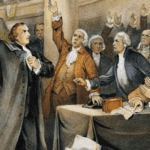Sipping more coffee these days? Laboring at home and traveling less, I find myself more frequently appreciating a good brew, as well as an invention that is to coffee what the slicing machine is to bread. I’m referring not to a burr grinder or a French press or a Keurig machine, but to the lowly paper filter invented just 112 years ago.
More on the filter and its female inventor in a moment. First, some interesting coffee facts I learned from personal experience or during research for this article.
The Evolution of Coffee
In the last 500 years, coffee went from an exotic libation confined to east Africa to as universal a beverage as there is, aside from water itself. According to historian Jonathan Morris in his Coffee: A Global History,
Coffee is a global beverage. It is grown commercially on four continents, and consumed enthusiastically in all seven: Antarctic scientists love their coffee. There is even an Italian espresso machine on the International Space Station.
I’ve been drinking coffee since 1982, but until a visit to Taiwan about five years ago, nothing else had eaten the beans before they became the grounds that made all the brown stimulant I drank.
It was in the Taiwanese capital of Taipei that I tried my first cup of coffee made from the droppings of civets, a tropical forest cat. The animal first eats the coffee cherries that fall to the ground, then excretes the beans—a truly “natural” de-pulping process. I couldn’t discern any special taste to the costly concoction, but I brought some home anyway just to introduce it to others. A long-time friend in Fuzhou, China still emails me from time to time and asks me if I’ve had any “sh*tty coffee” lately.
Coffee was likely first cultivated in Ethiopia in the 14th Century but a hundred years later, the epicenter of the coffee trade moved to Yemen, which then dominated the business for at least 200 years.
If you like a little chocolate mixed with your coffee, in what we today call a café mocha or a mochaccino, you’re drinking something whose name came from the city of Mocha in modern Yemen. From the late 15th Century to the early 18th, Mocha was the world’s leading port from which coffee was dispatched. By ship it traveled to cities throughout the Middle East, the Mediterranean and east Africa.
The first coffee houses in Istanbul opened in 1554 and within 40 years, their number reached 600. They attracted people who enjoyed the drink while gossiping against the regime. Scorning the coffee houses as dens of subversive iniquity, Sultan Murad IV ordered them all closed in Istanbul in 1633 and throughout the Ottoman Empire shortly thereafter. Just like America’s prohibition of alcohol three centuries later, this one simply drove coffee drinking underground until the government surrendered a few years later.
By the 1780s, an astonishing 80 percent of the world’s coffee poured forth from Caribbean islands, and most of that from what is now the Dominican Republic. It wasn’t until the 19th Century that Brazil emerged as a major producer, followed by Colombia and the Central American states.
The Coffee-Sugar War
A fascinating but brief coffee-sugar war erupted between 1897 and 1903. The principal figures involved were the American entrepreneurs Henry Osborne Havemeyer of American Sugar Refining Company and John Arbuckle of the giant coffee firm, Arbuckle Brothers. When Arbuckle decided to challenge Havemeyer by entering the sugar market, Havemeyer retaliated by muscling in on the coffee business.
The result was a price war from which both sugar and coffee consumers greatly benefited, but which yielded millions of dollars in losses for the two companies. It’s one of many failures of that great bogeyman theory, predatory price cutting. You can read more about it in FEE’s archives here.
It may come as a surprise but it’s the natural oils in coffee to which we owe the entirety of its glorious taste. As Antony Wild explains in Coffee: A Dark History,
Most coffee oils are immensely complex and have foiled the best efforts of scientists to simulate them adequately, which explains why artificial coffee flavoring is without exception of a poor standard. Although these oils constitute less than 3 percent of the end product by weight, without their presence coffee would neither smell nor taste of anything. In effect, 97 percent of the coffee one buys by weight is tasteless, baked vegetable matter and caffeine, which is unaffected by the roasting process and constitutes between 3 and 6 percent of the final weight of the coffee.
Until the early 20th Century, all the major names associated with coffee were those of men—from sultans to shippers to industrialists. Then along came a diminutive housewife in Dresden, Germany named Melitta Bentz. In classic entrepreneurial fashion, she was alert to a problem, solved it, then took the risk of creating a company to market her invention, and succeeded.
Melitta’s Contribution
Melitta Bentz was 35 in 1908 and frustrated with grounds in her coffee. It was a common complaint but one the rest of the world seemed willing to tolerate. Percolators of the day over-brewed coffee at the expense of its taste, imparting an annoying bitter flavor. Linen rags would retain the grounds but were messy and required frequent cleaning. Surely, something else could provide an appealing compromise, she thought, and be quicker, easier and cleaner.
She experimented with several materials. She wasn’t satisfied with any of them until she grabbed some blotting paper from her son’s school book, punctured it multiple times with a nail, put it in a brass pot she filled with coffee grounds, then poured hot water over it. Bingo! No bitterness, no grounds! It was an instant hit with her friends, switching on the proverbial light in Melitta’s entrepreneurial brain.
Melitta was granted a patent for her filter in July 1908 and within months, her company was up and running with its initial four employees: Melitta herself plus her husband Hugo and sons Willy and Horst. Producing filters at first within their home, they sold more than a thousand of them at the Leipzig Fair in 1909. Demand for the simple, newfangled invention exploded thereafter. In 1936, Melitta improvised her original design and turned her filter into the now-famous cone shape with which we are all familiar.
Melitta’s Legacy
Production of the filters was paused briefly by World Wars I and II but surged again afterwards in each case. But for those interruptions, the family-owned business flourished for decades, even after Melitta’s death in 1950. Today it employs thousands in Germany, Florida and New Jersey. A belated obituary in The New York Times in 2015 quoted a company spokesperson as saying,
Most Melitta locations still have a photograph of her on the wall. Every employee knows Melitta Bentz and her exceptional role as the mother of the corporation.
I don’t know if the millions of coffee filters sold by her company made Melitta Bentz rich or not. I’m guessing she might well have made it into the income category some envious people disparagingly label as “the one-percent.” If so, that would actually make my coffee taste even better.
Melitta Bentz is an important figure in the storied history of one of the world’s most popular beverages. She came up with a better idea. She possessed the courage to invest in it. She earned the willing patronage of millions of happy customers. She employed thousands of people. She hurt no one in the process; indeed, she left the world in a small way better than when she found it.
Not bad for a housewife from Dresden.
For additional information, see:
“John Arbuckle: Entrepreneur, Trust-Buster, Humanitarian” by Clayton A. Coppin
“The Predatory Bogeyman” by Lawrence W. Reed
Uncommon Grounds: The History of Coffee and How It Transformed the World by Mark Pendergrast
Coffee: A Global History by Jonathan Morris
Coffee: A Dark History by Antony Wild
A Rich and Tantalizing Brew: A History of How Coffee Connected the World by Jeannette M. Fregulia
“Overlooked No More: Melitta Bentz, Who Invented the Coffee Filter” by Claire Moses
“Melitta Bentz, Beating the Grinds” – A 4-Minute Video

Lawrence W. Reed
Lawrence W. Reed is President Emeritus, Humphreys Family Senior Fellow, and Ron Manners Ambassador for Global Liberty at the Foundation for Economic Education. He is also author of Real Heroes: Incredible True Stories of Courage, Character, and Conviction and Excuse Me, Professor: Challenging the Myths of Progressivism. Follow on Twitter and Like on Facebook.
This article was originally published on FEE.org. Read the original article.





1 comment
… [Trackback]
[…] Find More on on that Topic: thelibertarianrepublic.com/how-a-german-housewife-fed-up-with-grounds-in-her-coffee-revolutionized-the-famous-drink/ […]